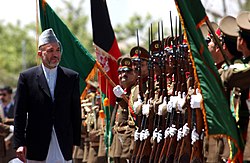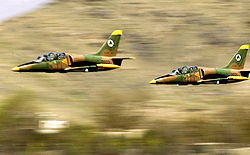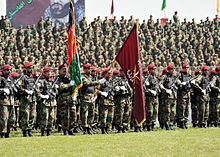Afghan National Army
The Afghan National Army ( Pashtun د افغانستان ملي اردو, Persian اردوی ملی افغانستان, ANA for short ) is the army of the state of Afghanistan that is still being established . It was founded on April 3, 2002. In March 2011 the troop strength was around 150,000. On August 20, 2014, the troop strength was around 195,000 soldiers , 6,000 of them from the Air Force (AAF). The Afghan National Security Forces (ANSF) generally refer to all Afghan security forces, including the Afghan National Army (ANA) and the Afghan National Police (ANP). The ANSF should grow to a total of around 400,000 security guards.
history
Development until 2001

An Afghan army had existed since the middle of the 18th century after the wars against Persia . It comprised a salaried tribe as the core, which was followed by a militia group during the war . In the Anglo-Afghan wars , the Afghans were able to hold their own against the military interventions of the British Empire until 1880. In 1880 the British occupied Kabul. The British commander General Frederick Roberts sat Abdur Rahman Khan , son of the eldest son of Dost Mohammed Khan Afzul, as the new Emir one. The British took control of Afghan foreign policy for the next 40 years. Organization and arming of the army were organized on a European basis under Abdur Rahman Khan. In 1884 the army numbered around 50,000 men and 123 field guns. Due to numerous uprisings in Afghanistan in 1893 the country was divided from the British by the Durand Line and the southeastern area was incorporated into the Indian Crown Colony . In 1904 the Madrasse-ye Harbi-ye Military School was founded by Habibullah Khan to improve the training of army officers.
In the third Anglo-Afghan War in May 1919, the Afghan army under Amanullah Khan was able to achieve success against the British Indian Army , which led to the recognition of Afghanistan as a sovereign and independent state by Great Britain on August 8, 1919. In 1924 the first air force unit was set up, which existed until 1929. In 1925, Amanullah Khan proclaimed the Kingdom of Afghanistan . Under Zahir Shah , the army reached 70,000 men in 1933. The Afghan Air Force , which was re-established in 1937, received its first modern combat aircraft in 1957. In 1967 32 machines were in service with the armed forces. The Afghan pilots were trained by local flight schools.
In 1973, Zahir Shah was overthrown by his cousin and brother-in-law Mohammed Daoud Khan . In 1978 there was a pro-communist military coup. With the invasion of Soviet troops in December 1979, the civil war developed into a ten-year proxy war between the Afghan army and the Soviet occupying power on the one hand and the mujahideen, supported by the USA , Saudi Arabia and Pakistan , on the other. In the 1980s, the existing MiG-17 , MiG-21 and Ilyushin-Il-28 aircraft as well as Mil Mi-24 helicopters of the Afghan Air Force were used in the fight against the mujahid. Morale in the government-loyal Afghan army deteriorated. The Afghan army collapsed from its original strength of 105,000 men in 1978 to around 20,000 to 30,000 men in 1987. In 1989 the Soviet troops withdrew from Afghanistan. The Soviet-backed government under President Mohammed Najibullah was able to hold out until the mujahideen captured Kabul in 1992. The army units that were still in existence until then disintegrated or joined various camps.
The Taliban were taking the capital Kabul in 1996 and control of the following consolidation of their power since 1997, three-quarters of the country. The various militias also had remaining units of the army; for example, towards the end of the 1990s, both the Taliban and the Northern Alliance were using Afghan air force fighter jets. After the attacks in the USA on September 11, 2001 , the USA attacked Afghanistan on October 7, 2001 and supported the United Islamic Front for the Rescue of Afghanistan in order to overthrow the Taliban and with it their leader, Mullah Omar (see also War in Afghanistan ) .
Younger development

After the end of the war in Afghanistan , Afghan President Hamid Karzai set the goal of setting up an army with 70,000 soldiers by 2009. This was last confirmed as an objective in the Afghanistan Treaty at the end of January 2006 . According to this, a nationally respected, professional and ethnically balanced Afghan National Army (ANA) with up to 70,000 soldiers should be fully functional by 2010. By the end of 2009, the ANA had already reached 97,000 soldiers. As a result, the goal was given to increase the number of soldiers by 2015 [out of date] to around 260,000.
In January 2003 the first 1,700 volunteers were accepted into five kandaks (paschto. For battalion ). There they were trained in a ten-week basic training course, carried out by ISAF soldiers. In June 2003, 4,000 soldiers had already been trained. However, they faced regional armies of the so-called warlords with an estimated strength of 40,000 men.
The quota of people leaving, which was initially 50 percent, fell to 30 percent in mid-2003. New units at this time lacked weapons and communication systems. In the summer of 2003, there were finally ten percent deserters per month. That number fell to 1.2 percent per month in 2004.
In the initial phase, the Tajiks were clearly overrepresented in the ANA, but efforts are now being made to get an appropriate proportion of Pashtuns , Uzbeks and Hazara in the ANA by introducing quotas .
Problems with the set-up were also caused by the slow support from the funds promised at the Afghanistan conference . The strong fluctuation among the soldiers hindered the construction. Notwithstanding this, in July 2003 the first 1,000 soldiers under the command of US-led troops were able to take part in the so-called war on terror . In February 2005, the ANA finally had 21,200 soldiers, 17,800 of whom were trained and 3,400 were in training.
Under pressure from the strengthened Taliban, Afghan officials estimated in October 2016 that the ANA and police would lose around 5,000 men per month to desertion and enemy action.
organization

structure
The ANA will initially remain limited to army tasks. Since the establishment and maintenance of an operational air force is beyond the means of the army , the USA takes over the security of the Afghan airspace . The structure of the command structure is influenced by the USA. So should Afghanistan be divided among military meaningful regional commands, similar to the organization of the US armed forces . The army is divided into 31 (2005) battalions (Kandaks) of up to 650 men, 28 of which were operational in 2005. The plan was to have nine brigades , each with six battalions, ready for action by the end of 2006 . These are then to be distributed across the country to five corps . The following have already been launched:
- 201st Corps , based in Kabul
- 203rd Corps , based in Gardez
- 205th Corps , based in Kandahar
- 207th Corps , based in Herat
- 209th Corps , stationed in Mazar-i-Sharif (of the Bundeswehr supported) with brigades stationed in Mazar-e Sharif and Kunduz (2009).
In addition to these five regional corps, there is also an Army Aviation Corps . In December 2009 it was announced that another corps, the 215th Corps , would be set up in Laschkar Gah in Helmand Province . Each corps consists of three to four brigades . A brigade usually consists of four infantry kandaks, one kandak for combat support, one for logistics and a GSU kandak (Garrison Support Unit). Each corps also has a command kandak, which is managed centrally by the Ministry of Defense in Kabul in coordination with the respective regional command .
Commanders
- Lt. Gene. Sher Mohammad Karimi , Commander of the General Staff ,
- Mohammad Eshaq Noori, Deputy Commander of the General Staff
- Abdul Abdullah, Deputy Commander of the General Staff
- Abdul Khaliq Faryad, Deputy Commander of the General Staff
- Anwar Masoud Langerkhel, Deputy Commander of the General Staff
Workforce
| army | 6,000 | 24,000 | 26,000 | 36,000 | 50,000 | 68,000 | 100,000 | 150,000 | 164,000 |
| year | 2003 | 2004 | 2005 | 2006 | 2007 | 2008 | 2009 | 2010 | April 2011 |
The problem of the ANA in building solid structures was initially the great fluctuation among the soldiers. It was estimated that 10 percent of soldiers left the army after a short time. The starting salary in the ANA was 30 US dollars , and it rose gradually for trained soldiers up to 70 US dollars. Many of the recruits were under the age of 18 and could neither read nor write. This created major communication problems. Due to the inhomogeneous ethnic and linguistic structure of Afghanistan and thus also of the army, problem-free communication is therefore not possible either verbally or in writing. In 2006 the ANA employed a total of around 35,000 people, including around 27,000 operational soldiers.
Western aid

Equipment and infrastructure
The US sees the establishment of an Afghan national army as an alternative to the permanent stationing of US forces in Afghanistan. Since 2001, they have military equipment and services worth more than 2 billion USD provided for the ANA are available. Another $ 2 billion program was announced in 2006 and is planned for 2007. It includes 2500 Humvees and 10,000 M16 assault rifles. In addition, a national command center is to be set up. However, Afghan units are still for the most part armed with old Soviet-made weapons, equipment and vehicles.
The 209th Corps is replacing its weapons of Soviet origin with several different weapons from NATO countries, including the M16 , M240 B machine gun, M249 SAW, M2 machine gun, and the M24 sniper rifle. Another program was announced in 2011 and is planned for 2012 [obsolete] . It contained 440 M1117 Guardian Armored Security Vehicle .
In the meantime (2006) all Afghan battalions are sufficiently motorized, even if they are makeshift. A military college has been set up in Kabul to train the armed forces' elite over four years. The university is supported by the US and Turkish armies . There is a central training camp near Kabul for training soldiers, the Kabul Military Training Center .
Canada and Norway have announced support from Leopard 1 main battle tanks to make the ANA more independent in the fight against the Taliban. [outdated]
In 2012, Afghanistan was added to the US list of its most important allies outside of NATO . This gave the country preferential access to selected armaments programs.
The US is taking on the brunt of building Afghan air warfare capacities , which are bundled in the Afghan National Army Air Corps (ANAAC) , which is also supposed to take on non-military tasks due to budget constraints. According to Jane's Defense Weekly , ANAAC has just under 35 aircraft and is aiming to expand to 128. Due to the long Soviet presence, the 187 pilots, whose average age in May 2009 was almost 45 years, are practicing with aircraft and helicopters of the types An-32 , MiG-21 , Mi-17 and Mi-35 . At this point in time, the corps had a staff of around 2,500 and is aiming for an expansion to 7,250 by 2016. In December 2008 six Mi-35s from Czech stocks were delivered for the ANAAC. A squadron for close air support with Embraer EMB 314 is under construction .
Despite the modernization with Western weapons technology, the ANA will continue to hold on to its Soviet equipment stocks, but their maintenance and repair causes major problems due to a lack of adequately trained personnel. As part of the NATO-Russia Council, NATO has therefore announced the establishment of a fund to train suitable ground personnel for the helicopter fleet, in which the Russian Federation will also contribute financially.
education
The army is being trained by the coalition forces of the ISAF in order to independently ensure the security of the country in the future. The different members of the ISAF have taken on different responsibilities in the training of the ANA. All of these various efforts are managed on the coalition side by the Afghanistan Combined Command (CSTC-A) and coordinated from ISAF headquarters in Kabul. Since July 2006 the Afghan National Army Training Command (ANATC) has been in existence, which provides for close cooperation between ISAF and the ANA General Staff.
The training under the direction of the ANATC headquarters provides for basic training by Afghan military instructors who have meanwhile been trained. The US Armed Forces take care of the advanced training. Great Britain and France direct the training of candidate officers , who are primarily composed of experienced civil war veterans.
The Bundeswehr is currently providing three Operational Mentoring and Liaison Teams ( OMLT ) in Mazar -e Sharif in northern Afghanistan , is participating in another one in Kunduz and is planning three more there by the end of the year. In Kabul , the Bundeswehr is working with France to support the expansion of the school for drivers and mechanics into a logistics school. Germany is in the lead. In July, the new school plans to start training specialist staff. After all, the Bundeswehr provides up to 50 soldiers for mobile training teams who are deployed when necessary.
See also
Web links
- The Afghan Army on globalsecurity.org
- handelsblatt.com: Report - A visit to the Military Training Center (KMTC) in Kabul
Individual evidence
- ^ Afghanistan since the end of the monarchy In: derstandard.at of June 1, 2006.
- ↑ Caroline Wyatt: Can Afghan National Army survive NATO exit? , BBC News, March 9, 2011, accessed December 28, 2011
- ^ Report on Progress Toward Security and Stability in Afghanistan ( Memento from November 2, 2014 in the Internet Archive ) In: www.defense.gov from October 2014.
- ↑ WebCite - Obama 'mulls Afghan army boost' ( Memento from February 11, 2011 on WebCite )
- ^ Meyers Konversationslexikon from 1888: Afghanistan
- ↑ Key points of the "Afghanistan Pact" In: tagesspiegel.de of January 31, 2006
- ^ "Afghan Security Forces Grow in Numbers"In: defense.gov of August 5, 2011
- ↑ "Obama 'mulls Afghan army boost'"In: news.bbc.co.uk from August 5, 2011
- ↑ Karzai: Afghanistan still needs international help ( memento of October 27, 2006 in the Internet Archive ) in Deutschlandradio of November 19, 2004
- ↑ Disamarment and Reintegration in Afghanistan International Crisis Group Asia report No. 65 September 30, 2003 p. 5
- ^ Elections in Afghanistan Asia Briefing of the international Crisis Group on March 30, 2004
- ↑ a b Afghanistan: Getting Disarmament Back on Track Update briefing of the International Crisis Group of February 23, 2005 p. 4
- ^ Afghanistan: Getting Disarmament Back on Track Update briefing of the International Crisis Group of February 23, 2005 p. 3
- ↑ Stanekzai Zainullah: "Taliban fighters ambush, kill dozens of retreating Afghan troops" Reuters of October 13, 2016
- ↑ Deb Riechmann: Little resistance on day 2 of US-Afghan offensive. news.yahoo.com, December 5, 2009, archived from the original on December 15, 2009 ; Retrieved September 6, 2012 .
- ^ Brookings Institution: Ian S. Livingston, Michael O'Hanlon; Afghanistan index of July 31, 2011 , tables 1.5, 1.12, 1.29
- ↑ Thomas Withington: Army Plan Fraught With Problems Reporting Central Asia No. 110 of the Institute for War and Peace Reporting, March 21, 2002
- ^ Tini Tran (Associated Press): Afghanistan to get $ 2 billion in US gear In: agfhannews.net of July 4, 2006
- ↑ facebook.com: Train the Trainer Course , accessed February 1, 2011
- ↑ www.defensenews.com ( Memento from July 30, 2012 in the web archive archive.today ) Afghanistan To Get 440 Armored Security Vehicles
- ↑ Archive link ( Memento from January 4, 2008 in the Internet Archive )
- ↑ Rolleiv Solholm: Afghanistan may get Norwegian tanks. In: norwaypost.no. The Norway Post, October 25, 2006, archived from the original on October 22, 2007 ; Retrieved September 5, 2012 .
- ^ Wasserbly, Daniel: US looks to build Afghan air corps , in: Jane's Defense Weekly , Volume 46, Issue 22, June 3, 2009, p. 8.
- ↑ https://www.dvidshub.net/news/27835/combined-security-transition-command-afghanistan-refurbishes-donated-helicopters-help-build-afghan-air-corps
- ↑ Afghan Air Force receives first four A-29s
- ↑ Afghanistan to receive six more Super Tucanos, Janes, October 25, 2017 ( Memento from October 26, 2017 in the Internet Archive )
- ↑ german.ruvr.ru: NATO and CSTO should work together to prevent drug smuggling from Afghanistan: Voice of Russia ( Memento from January 29, 2012 in the Internet Archive ) , accessed on May 5, 2011
- ↑ www.bundeswehr.de For self-sustaining security in Afghanistan August 15, 2009 ( Memento from December 2, 2008 in the Internet Archive )




